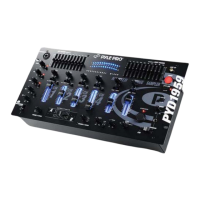
Do you have a question about the Pyle PYD1919 and is the answer not in the manual?
| Brand | Pyle |
|---|---|
| Model | PYD1919 |
| Category | Music Mixer |
| Language | English |
Details on microphone, phono, and line input sensitivity and impedance values.
Specifies the output voltage and impedance for amplifier, zone, and record outputs.
Defines the mixer's frequency response within a +/- 3 dB tolerance.
Provides S/N ratios for mic, phono, and line inputs measured at 1 kHz.
Lists the total harmonic distortion percentages for mic, phono, and line inputs.
Details equalizer frequencies, boost/cut range, and MIC tone control settings.
Specifies talkover attenuation and echo delay time for specific models.
Information on power requirements and the physical dimensions of the mixer.
Details the two-year limited warranty, service procedures, and required return information.
Connects external effects processors like digital samplers or synths to the mix.
Allows connection of high-level audio sources such as CD players, tape decks, or tuners.
Covers MIC 1/2 combo/input jacks, level, tone controls, and talkover function.
Details channel gain, input selection, and CUE switches for audio monitoring.
Describes output jacks (Amp, Zone, Record) and turntable grounding.
Manages overall mixer volume, stereo/mono selection, and balance for master and zone outputs.
Includes headphone level, CUE/PGM control, dual display meter, BNC lamp, and power switch.
On/Off switches for the 10-band equalizer and external effects loop.
Allows smooth audio source switching between assigned channels using the crossfader.
Manages echo delay, repeat time, and overall echo effect level and activation.
Covers MIC talkover, MIC levels, channel gain, input selectors, CUE switches, EQ, and master/zone controls.
Features for selecting, controlling pitch (speed), and volume of eight pre-programmed sound effects.
Includes MIC talkover, MIC levels, channel gain, input selectors, CUE switches, EQ, and master/zone controls.
Features echo controls (delay, repeat, level) and sound effect controls (CUE, volume, speed).
Covers MIC talkover, MIC levels, channel gain, input selectors, CUE switches, EQ, and master/zone controls.
Includes sampler start/stop, mode selector, pitch control, CUE, and level controls for sampled audio.
Covers MIC talkover, MIC levels, channel gain, input selectors, CUE/sample switches, EQ, and master/zone controls.
Recommended initial settings for controls before connecting AC power or turning on the unit.
Instructions for connecting sources like CD players, tuners, or VCRs to line inputs.
Guidance on connecting turntables to phono inputs and securing ground wires.
How to connect the mixer's main output to an amplifier or receiver for playback.
Connecting the mixer's record output to a tape deck or digital audio recorder.
Connecting to secondary amplifiers for DJ booth or remote location speakers.
Instructions for using headphones for private listening and cueing, with safety advice.
Guidance on connecting a 12V/3W lamp to the mixer's dedicated lamp socket.
Steps for powering on the mixer and connected audio sources safely.
How to use headphone cueing to monitor specific input sources before mixing.
Procedure for blending multiple audio sources and microphones into the main mix.
Using the 10-band equalizer to tailor sound to acoustic surroundings or preferences.
Blending microphone voice into the mix, including talkover mode and tone adjustments.
Utilizing kill switches to eliminate specific frequency ranges from microphone inputs.
Selecting mono or stereo output for master and zone channels.
Using the crossfader and assign switches for smooth transitions between audio channels.
Adjusting echo delay, repeat, and level for the built-in echo effect.
Selecting and controlling pre-programmed sound effects for enhanced mixes.
Recording, playback, looping, and pitch adjustment of digital audio samples.
Provides solutions for common problems like no power, no signal, hum, or feedback.
Tips for keeping the mixer clean, dry, and in good working condition.